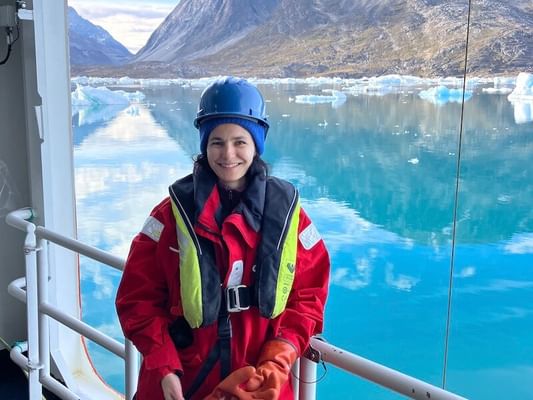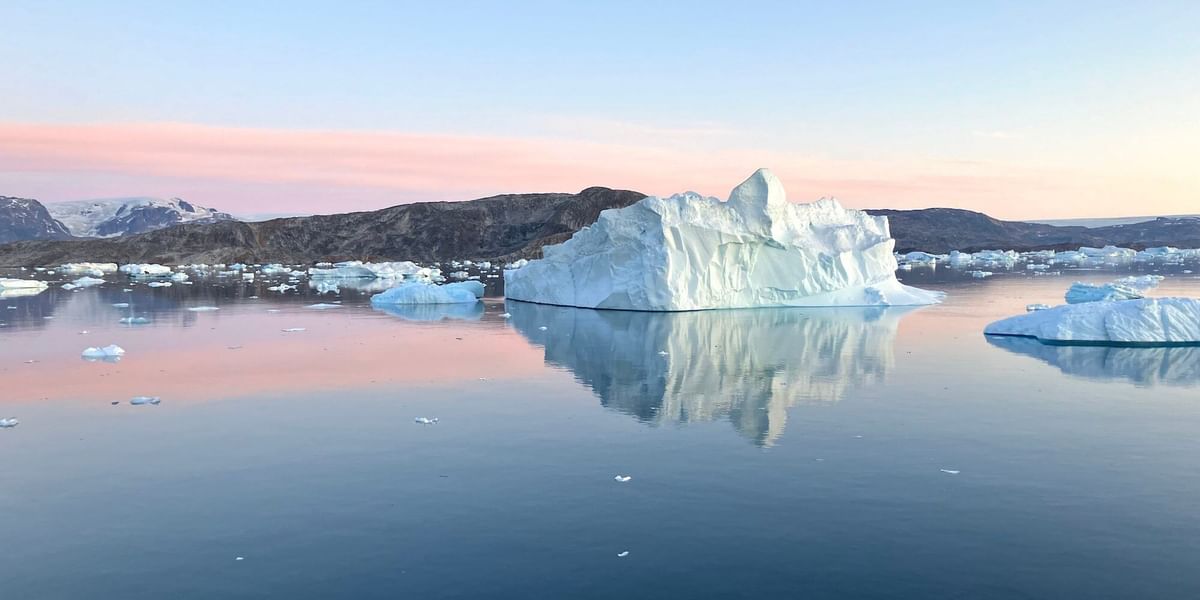- Undergraduate
Bachelor's Degrees
Bachelor of ArtsBachelor of EngineeringDual-Degree ProgramUndergraduate AdmissionsUndergraduate Experience
- Graduate
Graduate Experience
- Research
- Entrepreneurship
- Community
- About
-
Search
All Thayer News


Dartmouth Researchers Collaborate to Better Predict Sea-Level Rise
Oct 18, 2023 | by Catha Mayor
Professor of Engineering Hélène Seroussi and Professor of Earth Sciences Mathieu Morlighem will share a $1 million grant from Denmark's Novo Nordisk Foundation to study sea-level rise. The project—part of a larger effort led by Technical University of Denmark—aims not only to improve projections of sea level rise but also to establish a "Center for Ice-sheet and Sea-level Predictions." We spoke with Professor Seroussi about her role in the effort:

Professor Seroussi traveled to Greenland to study how the fjord systems there are changing. (Photo courtesy of Hélène Seroussi)
What are ice sheets, and how did you get involved in this field?
Ice sheets are formed by a slow accumulation of snow that builds year after year. Eventually, it compacts under its own weight to form ice, and starts deforming and flowing. It's different from the ice that's formed by the freezing of the ocean as we see in the Arctic, for example.
Today, we have two ice sheets on earth, one in Greenland and one in Antarctica. During my PhD, we were starting to see large changes in these ice sheets and I began working on numerical models to understand how and why they flow and evolve over time. It's been over 15 years now and we're still improving the models and refining our understanding of how ice sheets are responding to climate change.
How did you get involved in this project?
I've been collaborating with colleagues in Denmark for a number of years. With this project, we are going to use new remote sensing and fieldwork data to better calibrate our existing models. With that, we hope to improve our projections of ice sheet changes in Greenland and Antarctica.
Where is this new data coming from?
Most of the data come from satellites. Over the past decade, the number of observations of the surface of the ice sheets has grown exponentially. We have very limited observations, however, of what's happening at the base of the ice or within the ice column, such as the temperature or the friction at the base. If we want to improve projections of how ice sheets are going to change, we need to know what's happening everywhere. So we use models to infer these things based on the observations we have at the surface.

Ice sheets are starting to flow faster and discharging more ice into the ocean. (Photo by Hélène Seroussi)
Why do we need to predict what's going to happen to these ice sheets?
It's important to understand why and how they're changing both for scientific curiosity and for societal reasons. One of the biggest consequences is that as ice sheets lose mass, this causes sea level rise over the entire planet. More than half of the sea level rise we're experiencing today is coming from land ice, including in Greenland and Antarctica. And we expect this to increase even more in the future.
The biggest uncertainty is around what the Antarctic ice sheet is going to do in the next few decades and century, how it's going to respond to warm waters from the Southern Ocean getting in contact with the ice. If we want to be prepared for what's going to happen with sea level rise, we have to be able to predict this.
Is it just about knowing how quickly the ice is melting?
Everyone thinks about melting at the surface when you have warmer air conditions, but that's only half the problem. The other half of the mass loss in Greenland, and most of the mass loss in Antarctica, is happening because ice sheets are starting to flow faster and discharging more ice into the ocean. And this increase in discharge is not compensated by additional snowfall.
Why is this happening? Well, we have warming oceans that are touching the ice sheets. The ocean melts the ice at the fronts of glaciers in Greenland and at the base of ice shelves in Antarctica. And as the forces that the floating ice shelves exert on the inland ice is reduced, it starts flowing faster and faster.
This is what we call marine ice sheet instability. It's a mechanism that can cause rapid and sustained discharge from the Antarctic ice sheet, and the collapse of entire basins over a few decades. We know these things have happened in the past, and we know it's likely to happen in Antarctica, but we don't know when.
The problem is, even if we were to stop carbon emissions tomorrow, the ice will continue its slow response to climate change for centuries. And so, we want to know how it will inevitably change, and prepare ourselves for future sea level rise.
For contacts and other media information visit our Media Resources page.
